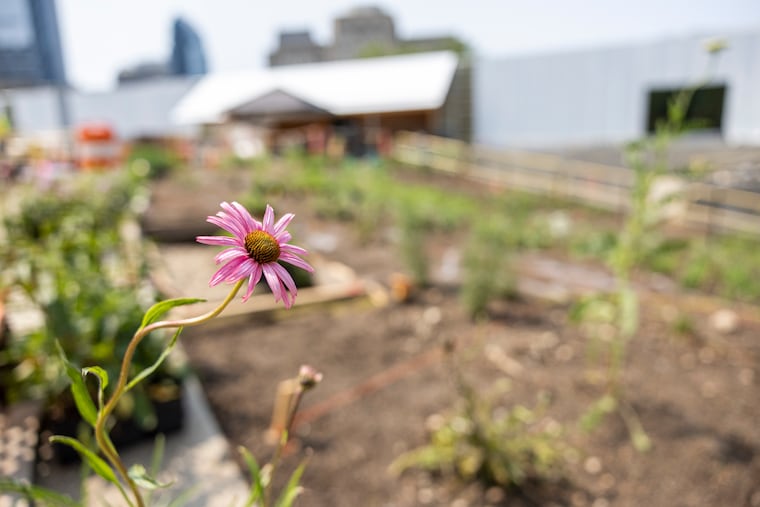The gardens are coming to life at the future Calder Gardens
Philadelphia will soon home its own Piet Oudolf garden. The world-famous designer's best known works also include the stylized meadows atop the High Line in New York City.

In Detroit, where the world-famous landscape designer Piet Oudolf has planted one of his celebrated gardens, the staff tells visitors to keep coming back.
The cycle of the garden — bloom, die, decay, renew — is key to Oudolf’s aesthetic. Even the skeletal stems and seedpods on display in the winter have been carefully curated as an intrinsic part of the design: A life in four seasons.
“It’s such a complex plant palette that it’s just changing weekly,” said Meredith Simpson, chief operating officer of Oudolf Garden Detroit. “It builds and gets a little quieter in fall in a whole different way — more subtle colors. Even people who don’t like gardens come and get quiet and start feeling something.”
By Sept. 21, with the opening of Calder Gardens, Philadelphia will be home to its own Oudolf creation. The Dutch designer’s best known works also include the Lurie Garden at Millennium Park in Chicago and the park atop the High Line in New York City.
On Wednesday, a team of horticulturists and landscape designers from near and far toiled to bring to life Oudolf’s latest creation, Calder Gardens, the long-awaited showcase for one of Philadelphia’s most famous artists on Benjamin Franklin Parkway.
The exhibition space and garden dedicated to sculptor Alexander Calder represents the first addition to Museum Row since the relocation of the Barnes in 2012.
The garden features a reflective stainless steel-paneled structure designed by Herzog & de Meuron, where a rotation of Calder’s sculptures and other art will be displayed. Outside, Oudolf’s wild urban meadow will bloom and die and begin again, anew, ever-changing.
“The garden is a piece of art,” said Hanna Packer, a landscape designer, who has worked with Oudolf for 15 years and has been overseeing the planting.
A poet with plants
Working in the sun, a team of volunteers, including Simpson, and other horticulturists from Chicago and Detroit, and Erin Conley Monda, Calder Gardens’ horticultural manager at the Barnes Foundation, the garden’s operational partner, meticulously planted perennials on sprawling, sloping beds outside the exhibit space — to Oudolf’s exact specifications.
His working sketches for gardens are artworks in themselves, and have been exhibited in galleries around the world.
Oudolf, 80, first opened a nursery in the Netherlands with his wife, Anja, in the 1980s. For him, planting a garden is a promise. Unlike old English gardens, his designs are not static; he’s not interested in maintaining what he lays out on day one. Rather, he has said, he puts his plants onstage and lets them perform, maturing into something more beautiful. It’s an approach toward gardening that utilizes nature, wildness, and time.
His knowledge of plant life is considered almost preternatural.
“He knows the plants, how they grow, what they become, and also how they can be combined in certain ways to induce certain emotional responses,” said James Corner, professor emeritus at the University of Pennsylvania and director of Field Operations, the New York landscape design firm that worked on the High Line with Oudolf. “He’s really an artistic poet with these plants. He just really knows how to paint with them, in an extraordinarily beautiful way.”
All year long, his gardens pulse with life and death. At the arrival of frost, the yellowing grasses and browning plants reveal themselves in crisp textures and stark silhouettes.
“We say a four season garden, but it feels like so many more than that,” said Kathryn Deery, director of horticulture at Lurie Garden. “Every time you come, there’s a different moment that’s been created just because of the timing of the blooms.”
Beyond beauty
Calder Gardens will be a stylized oasis with woodlands, dreamlike prairie meadows, and rivers of grasses running through it. On Wednesday, the team bedded out some of the 250 varieties of plants that will eventually populate the garden.
Plants with names like Red October, Hula Dancer, Meadow Rue, Hairy Beardtongue, and Stardust. And Sourwood, Snowbell, and Hackberry trees, and shrubs. All elegantly handwritten and color-coded on designs provided by Oudolf, who began envisioning Calder Gardens in 2022, and last visited earlier this month.
Oudolf wants his gardens to evoke feelings unique to each visitor — beyond the simple recognition of beauty. Nature brings out the strongest emotions in people, he’s said — and his gardens, despite the guiding hands of humans, can serve as little pieces of nature for urbanites escaping the bustle of the city.
The effect can be enchanting.
“You sort of don’t know where you are and feel a little disoriented in the best way possible,” said Simpson.
The design is key to Calder Gardens, which planners have portrayed not as a museum but as an interactive space for contemplation and introspection and community learning.
“We all have a sense, a longing for nature inside us that we don’t know how to name,” said Simpson. She pointed through the garden — still mid-installation — at a group of seemingly scattered plants. Once in bloom, though, they’ll catch your eye, then lead you through the landscape.
“You’ll see this little mystical group of purple [blooms] floating on top of these grasses, and that moment will create a little sparkle,” added Austin Eischeid, a Chicago garden and landscape design consultant working on the project. “You can’t name that as a first-time visitor. You just feel it.”
It will likely take two years for the garden to grow into the riotous aesthetic that is Oudolf’s signature — all those elements working together to evoke its fullest feeling. But that’s not to say Philadelphians should wait that long to see it: The growth of the garden is an art itself.